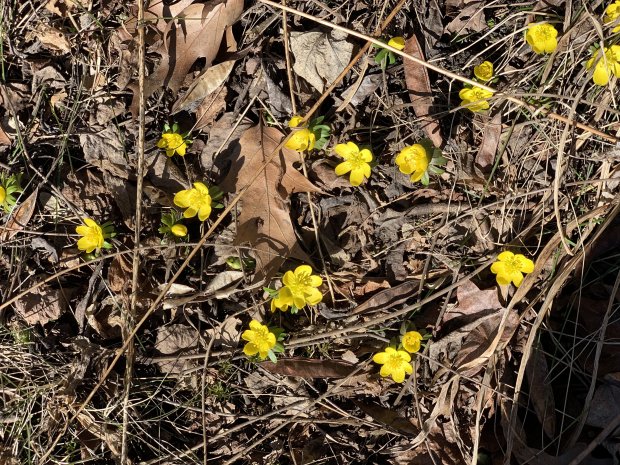The first blooms to open in late February and March are not native wildflowers, but the sight of them peering from the ground gets folks thinking about spring.
Winter aconite, for example, was in full bloom in February at Reed Turner Woodland. It’s one of the earliest bulbs to bloom in spring and is native to Eurasia. These cup-shaped sunny-colored flowers hugging the forest floor certainly cheered me as I walked toward a trail while a cardinal sang.
Soon, however, I encountered a path covered with wet, brown, decaying leaves. Then a whiff of autumn hit my nostrils. It was as if I had descended backward in seasonal time, reminiscing about the joys of fall.
A lake viewed from afar appeared wide open and free of ice, just as you would see in autumn. But at the lake’s edge, tree branches emerging from the water were encircled with a frozen crust. Suddenly, it was winter again, and I was entranced with the sculptures made of ice. A woodpecker, an active winter bird, rattled in the background.
This time of year, it’s easy to experience three seasons in one place, not only because of what you see and hear, but also because of what you smell. Scents reminiscent of fall may evoke childhood memories of jumping in a pile of leaves after raking them. Today people use leaf blowers, but the smell of autumn even in spring brings me back to the time when you could hear the sound of rakes rustling through the oak leaves, a sound much more pleasant than that of leaf blowers.
There is a winter smell, too, one that you may inhale on a cold autumn day, or on a colder-than-normal spring day. Perfume writer Marie Krnakova describes winter scents as being, “static, suspended in the air as if temporarily frozen in time and space.”
I walked closer to the ice-encrusted trees by the lake and inhaled that winter scent. Along with that came memories of me standing on ice skates, wobbling on a frozen pond, hoping not to fall before I made it to the other side.
Falling snowflakes absorb the odors they encounter such as plants and soil, creating the scent of winter, and even the smell of spring. Raindrops contain ozone, which easily reacts to other chemicals nearby, giving us the smell of, for example, the wet soil and emerging greenery.
As spring marches on, we are engulfed with scents, from blooming forsythias to bearded irises. Those scents also bring on the memories. For example, inhaling a lilac bloom can transport you back to your grandparents’ home which was surrounded by lilac trees.
I also get a whiff of summer sometimes on a warm spring day, even though there’s more than a month until the actual season begins. Air smells differently depending on whether it’s a cold or warm day. The molecules of odor move slower in cold air than in warm air.
To me, summer smells like an abundance of life, sometimes even an overload. Every once in a while when I’m walking a trail on a warm spring day, I get that overpowering whiff of summer and perhaps a memory of running through the sprinkler on a hot day.
When I smell summer approaching, I get nostalgic, not for the warm days but for the cooler days of blossoms and bird migration that dominate spring. Spring is my favorite season, and I can inhale its arrival even as ice and crystallized snow linger on the land.
Sheryl DeVore has worked as a full-time and freelance reporter, editor, and photographer for the Chicago Tribune and its subsidiaries. She’s the author of several books on nature and the environment. Send story ideas and thoughts to sheryldevorewriter@gmail.com.




